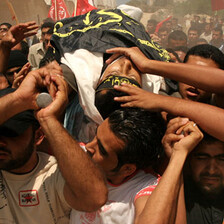Yedioth Ahronoth 10 April 2003
On the eve of the Iraq war, fears were expressed in different circles that under the cover of war, Israel might attempt a transfer of Palestinians in the “seam line” area of the northern West Bank (Kalkilya, Tulkarem). Last week, the army produced a scene from this scenario.
On April 2 at 3 a.m., a large force raided the refugee camp of Tulkarem, blocked all the roads and paths with barbed wires, and announced on loudspeakers that all males aged 15 to 40 must go to a certain compound at the center of the camp. At 9 in the morning, the army began to transport the gathered males to a nearby refugee camp. This time it was only a staged scene and the residents were allowed to return after a few days. But the producers of this show made sure that its significance would not escape the participants and the audience. They took special care that evacuation be done with trucks - an exact re-enactment of the 1948 trauma. As one of the residents described his feelings when he got on the truck, “All the memories and childhood stories of my father and grandfather about the Nakba came back” (Regular, Ha’aretz, March 4, 2003).
Many interpret this show as a “general rehearsal” for the possibility of a future transfer. There is no doubt that the current government is mentally prepared for transfer, but it is not certain that the “international conditions” are ripe for executing this in the way that was staged. The war Iraq has become too entangled for the U.S. to risk opening another flashpoint. But transfer is not just trucks. In the Israeli history of “land redemption” there is also another model, more hidden and sophisticated. In the framework of the “Judaization of the Galilee” project, which began in the 1950s, the Palestinians that remained in Israel were robbed of half their lands, isolated in small enclaves, surrounded by Israeli settlements, and gradually lost the bonds that held them together as a nation. Such an internal transfer is occurring now in the occupied territories, and it has been escalated during the war.
On March 24, the bulldozers reached the lands of the village of Mas’ha, which is near the settlement of Elkana, and began to mark there the new route of the separation wall, which will disconnect the village from all of its lands, as well as thousands of dunams belonging to Bidia and other villages in the area. Elkana is about 7 kilometers away from the green line, but the route of the fence was changed on June 2002 so that it will include Elkana as well in the Israeli side. Still, even in this plan, it is not necessary to take these lands from the villages.
It wasn’t only land greed that sent the bulldozers to the lands of Bidia and Mas’ha. These lands are on the western part of the Mountain groundwater basin - the large water reservoir originating in the West Bank, from which water flows under the ground also to the center of Israel. Out of six hundred million CM (cubic meters) of water that the Mountain reservoir provides in a year, Israel withdraws in different areas about five hundred million [1]. Control over the water sources has always been a central Israeli motivation for maintaining the occupation. The Labor governments of the seventies located the first settlements that they approved in areas defined as “critical locations” for drilling. Elkana was one of these settlements, founded within a plan that was given the (misleading) name “preservation of the sources of the Yarkon” [2]. Since the occupation in 1967, Israel prohibited Palestinians from digging new wells, but in the lands of Mas’ha and Bidia, as well as in lands that were already cut off from Kalkilia and Tul Karem, there are still many operating wells from before 1967. Their continued use may slightly reduce the amount that Israel can withdraw.
The residents of Mas’ha and Bidia, who are struggling to save their lands and livelihoods, set up protest tents along the bulldozer path. “Peace tents,” they called them in an outburst of hope. Palestinians, Israelis and internationals have been staying in these tents day and night to watch and stand in front of the bulldozers. I was there on Saturday. Around, in all directions, hills and hills of olive trees - huge areas of a green and pastoral landscape that one can find only where people live on their land for generations and generations, aware of its preciousness and beauty. And all this land is now being grabbed by the land redemptionists, who would dry its wells and sell it to real-estate investors.
Endnotes
1. These are the pre-Oslo figures for 1993, as quoted in Haim Gvirzman, “Two in the same basin,” Ha’aretz, May 16, 1993. According to the Palestinian Hydrology group, at the present, out of the annual recharge of the western part of the Mountain Groundwater Basin, which is 362 million CM/year, the total Palestinian withdrawal is only 22 million CM/year (www.pengon.org, Report #1).
2. Gvirzman, ibid.
Tanya Reinhart is a professor of linguistics at Tel Aviv University, and among the Israeli signers of the British boycott petition. She is the author of ‘Detruire La Palestine - ou comment terminer la guerre de 1948’, La Fabrique 2002; Israel/Palestine- How to end the war of 1948, Seven Stories, NY, 2002. The article above first appeared in Yediot Aharonot, April 10, 2003, and was translated from Hebrew by Irit Katriel.





